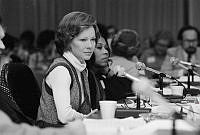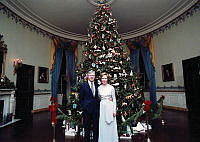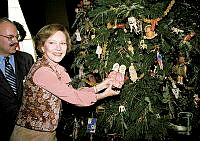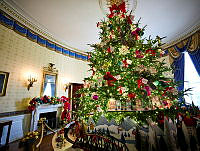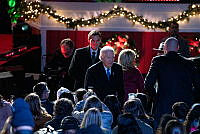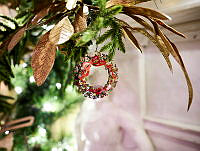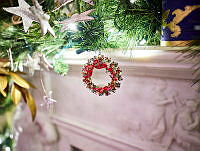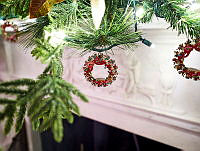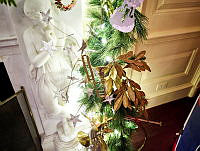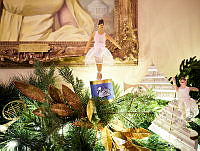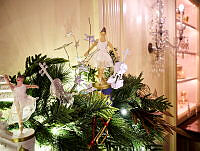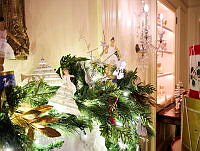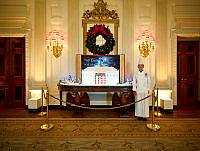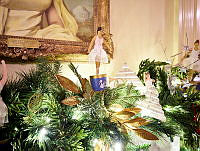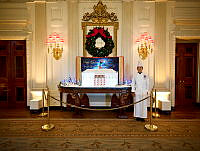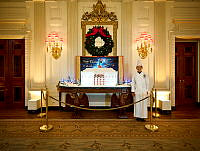Rubenstein Center Scholarship
White House Hostesses: The Forgotten First Ladies
First ladies hold a unique place in American history. The collection of first ladies' gowns and artifacts remains one of the most popular exhibitions, visited by millions of annual visitors at the Smithsonian National Museum of American History in Washington, D.C..1 First ladies are the focus of documentaries, podcasts, books, and scholarly works that examine their lives and contributions to the presidency, the White House, and American history. While the role of first lady is well known, it has no legal definition; it is neither a government position laid out in the Constitution, nor is it an elected position. Commentators, scholars, and American society have typically defined the role by marriage, elevating the status of presidential spouse, rather than focusing on the duties performed by these women; hosting events, serving as a personal and political confidant to the president, supporting political and social causes, and serving as a symbolic model of American womanhood.2 However, throughout history many daughters, sisters, and friends of presidents also fulfilled these responsibilities at the White House, though they are not bestowed the title of first lady because they were not married to the president. Instead, these women are often called White House hostesses, and deserve similar recognition from scholars, researchers, and institutions.
White House hostesses stood in for presidents who were widowed, unmarried, or whose wives could not or did not wish to perform White House social duties. The following women are known White House hostesses, though there are likely others who fulfilled the role:
- Martha Jefferson Randolph
- Emily Tennessee Donelson
- Sarah Yorke Jackson
- Angelica Singleton Van Buren
- Jane Irwin Harrison
- Priscilla Cooper Tyler
- Letitia Tyler Semple
- Margaret Elizabeth “Betty” Taylor Bliss
- Mary Abigail Fillmore
- Varina Davis
- Abby Kent Means
- Harriet Lane Johnston
- Martha Johnson Patterson
- Mary Arthur McElroy
- Rose Cleveland
- Mary C. Hoyt
- Mary Scott Harrison McKee
- Helen Taft Manning
- Margaret Woodrow Wilson
White House hostesses were often, but not always, young, unmarried relatives of the president or his wife, who were asked to help serve their country by assisting their family. Some women, including Martha Wayles Skelton Jefferson, Rachel Donelson Jackson, and Hannah Hoes Van Buren, are identified as first ladies despite passing away prior to their husbands’ presidencies.3 If these women, who did not live to see the White House, qualify as first ladies, then it seems only reasonable that their daughters, nieces, and daughters-in-law who served there would as well. This article explores three examples of previous White House hostesses who performed a more vital role than their title would convey, and as such, should be considered first ladies.

Portrait of Martha Jefferson Randolph, President Thomas Jefferson’s eldest living daughter, who served as White House Hostess. The portrait is by Thomas Sully ca. 1820-1830.
Library of CongressIn 1801, Thomas Jefferson became the first president to occupy the White House without a spouse. His wife, Martha Wayles Skelton Jefferson, died nineteen years prior on September 6, 1782.4 The couple’s eldest daughter, Martha “Patsy” Jefferson Randolph, accompanied Jefferson to Paris during his appointment as minister to France.5 Following her return from France, Martha married Thomas Mann Randolph in 1790.6 She remained a confidant to her father, and correspondence from this period shows that Jefferson often discussed his political career with his daughter, even disclosing to her his fears that the Federalist party would prevent the election of 1800 and cause the dissolution of the government.7
Martha was unable to join her father in the White House full-time. Instead, she resided primarily at Monticello and oversaw the education of her children while managing her father’s plantation and approximately 130 enslaved laborers working there.8 During the winters of 1802-03 and 1805-06, she traveled to Washington, D.C. to temporarily fill the role of hostess at the President’s House. The social season corresponded with the annual Congressional session in order to allow politicians to travel to D.C. in the winter and oversee their agricultural enterprises during the harvest season.9 Click here to learn more about the enslaved household of President Thomas Jefferson.
To prepare for winter at the White House, Martha called on Dolley Madison, wife of Secretary of State James Madison, for assistance. Martha asked her father to have Mrs. Madison, who had hosted some social events for President Jefferson, locate and acquire wigs for Martha to use during the social season.10 Martha’s decision to call on Dolley Madison for help shows her ability to navigate among the Washington elite women of the time, many of whom she knew quite well. Margaret Bayard Smith, another Washington socialite, reflected fondly of Martha Randolph’s first visit at the White House, writing:
I dined at the [President’s] since [his daughters] have been there and really passed a most delightful day. Before dinner he conversed with me and after dinner for two hours I had an interesting conversation with Mrs. R. She gave me an account of her children, of the character of her husband, and many family anecdotes. She has a rare but charming egotism which can interest the listeners in all one’s concerns.11
While Martha’s own letters do not detail her experiences in the White House, her success as hostess is evidenced by the respect that Martha earned from her father and her contemporaries. As the first White House hostess, Martha did more than just fill the role of de facto first lady. She successfully served as a political confidant for the president in private, navigated the social scene of Washington politics with the femininity Jefferson expected, and even gave birth to a child in the White House. In fulfilling these duties, she symbolized both a daughter and mother of Jefferson’s republic, serving as a model for woman of her class and social standing at the time.12
Martha Jefferson Randolph paved the way for subsequent White House hostesses. In 1841, Elizabeth “Priscilla” Cooper Tyler, daughter-in-law of President John Tyler, willingly stepped into the role of White House hostess to help fulfill the responsibilities of hostess despite the president’s wife, Letitia Christian Tyler, residing in the White House.

Drawing of Priscilla Cooper Tyler, wife of President John Tyler’s son Robert Tyler. Priscilla served as White House hostess for a portion of President Tyler’s time in the White House.
Library of CongressPriscilla Cooper Tyler, daughter of Mary Fairlee and the famous English tragedian, Thomas Cooper, had a career as an actress before marrying Robert Tyler on September 12, 1839.13 When her father-in-law, John Tyler, ascended to the presidency following the death of President William Henry Harrison on April 4, 1841, she took up social duties for Letitia Christian Tyler, who was unable to fulfill these responsibilities due to the aftereffects of a stroke.14 Even before she began to host social events in full, newspapers praised Priscilla, referring to her as “one of the most amiable and accomplished ladies in all the land” and suggesting that she would “honor the station to which… she has been elevated.”15
Tyler agreed, writing her sister that she was “plainly born to” host the variety of guests she received at the White House.16 Such guests included celebrities and foreign dignitaries, such as Napoleon Bonaparte’s officer Marshall Henri Bertrand, for whom she hosted a dinner, inviting over two hundred people and stating, “no party ever went off better.”17 Priscilla even managed to have a positive impact on President Tyler’s political adversaries, including John Quincy Adams. Although he was known to attack the president’s politics, Adams spoke positively of a party Priscilla hosted on the evening of June 12, 1842, in the “now gorgeously furnished East Room” of the White House, writing “The courtesies of President and of Mrs. Robert Tyler to their guests were all that the most accomplished European court could have displayed.”18
Despite the social success she provided to Tyler’s administration, in March 1844, just a few months before President John Tyler’s marriage to Julia Gardner, Priscilla Cooper Tyler relinquished her duties as White House hostess to her sister-in-law, Letitia “Letty” Semple, and moved to Philadelphia with her husband so he could begin his law career.19

Letitia Tyler Semple, President John Tyler’s daughter, who took over as White House hostess following Priscilla Cooper Tyler’s advocation of the role. Portrait by Charles King.
Library of CongressPriscilla’s own measure of her success as White House hostess would not come until a few years later. During a visit to Washington, Priscilla remarked, “Mrs. Adams, Mrs. Madison – everyone that is anyone – came to see us, and seemed so full of kindness and feeling that I was quite overpowered. I never realized before that the Washington people liked me for myself.”20
Her keen ability to reduce criticisms of the president she served, even if just in the social sphere, provides evidence of Priscilla Cooper Tyler’s success as hostess and should cement her as an important figure of American history, just like many other first ladies.21
While Priscilla Cooper Tyler primarily made her mark as hostess through incredible social success, Rose Cleveland, who occupied the position of White House hostess from 1885 to 1886, contributed great intellect to the role. Like Priscilla, Rose was known in her own right prior to her time in the White House as a teacher, linguist, and scholar.

Rose Cleveland circa 1910. Sister of President Grover Cleveland, Rose served as White House hostess before the president’s marriage to Frances Folsom in 1886.
Library of CongressRose Cleveland became the hostess of the White House in March of 1885, when her unmarried elder brother Grover Cleveland was inaugurated.22 Newspaper articles covering the Inauguration provided readers with details on Rose, lauding her intellect, scholarly pursuits, and promise for success in her new position, which was “synonymous with being the first lady of the land.” 23 Prior to her time in the White House, Rose studied at Houghton Seminary in New York, where, after graduating, she became a teacher and then a history lecturer.24 While serving as White House hostess, she continued to pursue her intellectual passions, publishing two books during her tenure; George Eliot’s Poetry and Other Studies (1885) and You and I: Moral, Intellectual and Social Culture (1886).
Rose’s well-respected intellect led to public discussion of her influence upon her brother. While previous first ladies and hostesses no doubt had intellectual and political inclinations, they were primarily private, while Rose’s occupied newspaper columns during the year she was hostess. One Washington correspondent for the Boston Globe wrote:
Although she is just a president’s sister, she has power, and she is just the one to use it, but wisely, kindly, and justly. She had an understanding with the president before coming here. It was definitive and business-like. The favor was largely from her to him.25
In December of 1885, newspapers speculated that Rose Cleveland influenced the president’s State of the Union, publishing accounts of literary experts dissecting which portions of President Cleveland’s remarks were written by his sister and commenting, “It is perhaps the first time in the history of the United States that a woman has contributed so important a State paper.”26 Such suggestions show that as an intellectual, Rose provided an early example of women in the White House whose influence through their relationship with the president was publicly considered and discussed. While this became more common in the twentieth century, Rose was one of the first women in the White House to be regarded seriously for her intellectual pursuits, thus showing the expansion of the role of White House hostess.

Newspaper article clipping from the St. Paul Daily Globe suggesting Rose Cleveland wrote part of President Glover Cleveland’s 1885 State of the Union remarks.
St. Paul Daily GlobeWhile Rose’s intellectual influence garnered press coverage, so too did her social influence. Reports on Rose’s early social events critiqued her for mistakes, such as which guests should go through and which stay behind when entering an event, and in March 1886 she was accused of encouraging women to dress immodestly at social functions.27 Still, Rose received praise for her fulfillment of social duties as hostess, lauded for her “right kind of motives” when she took on reforming social practices that had caused strife between the women invited to social events at the White House.28
When President Grover Cleveland announced his upcoming marriage to Frances Folsom in the early summer of 1886, the press closely observed Rose’s navigation of the social event. Leading up to and during the wedding on June 2, 1886, they reported Rose was a gracious hostess, “illustrating the devotion and determination that are her strongest characteristics.”29 After the wedding, Frances Folsom Cleveland assumed the home’s responsibilities and Rose left the White House to continue her independent scholarly pursuits, eventually moving to Italy with her romantic partner Evangeline Marrs Simpson Whipple.30 Like those hostesses who came before her, Rose Cleveland demonstrated that the role of White House hostess entailed more than orchestrating social events. Her position gave her unique influence as a political partner of the president, laying a path for the more discernible role first ladies would take in the twentieth century.
Today, first ladies are prominently recognized for their contributions, but the women who served as White House hostesses are often overlooked and underappreciated for their influence throughout American history. Martha Jefferson Randolph, Priscilla Cooper Tyler, and Rose Cleveland demonstrate that the title of first lady should not be solely defined by marital status to a president, but instead should reflect the critical, ceremonial roles fulfilled by a woman in the White House. These women further demonstrate that first ladies should be remembered for their skills, determination, character, and selfless service to their country.
About the Author
Rosie Cain is the Timothy and Anita McBride Term Fellow in White House History. Rosie is a second-year Public History Master’s student at American University, and she received her Bachelor’s in History from University of Colorado, Boulder in 2019. Rosie is passionate about women’s and gender history and 20th century U.S. history.












